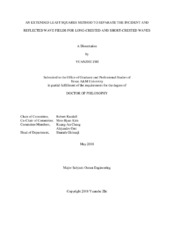| dc.description.abstract | An extended least square method for reflection analysis that separates long-crested or short-crested wave fields into the incident and reflected components from the measured wave surface elevations and from other wave parameters is presented. This method uses the least squares technique by minimizing the squared errors between the measured and the estimated wave heights. This method applies linear wave theory including the linear dispersion relationship and the transfer functions translating the surface wave elevations and other wave parameters. The wave parameters are measured simultaneously from several positions, and the wave probe measurements from three or an arbitrary number of the positions are selected for reflection analysis.
A probe spacing algorithm is described that determines the total number of the wave probes and their positions between the wave maker and the reflecting structure and selects three probes from the pre-arranged probe array for reflection analysis. The algorithm automates the arrangement of wave probes for a wave basin test involving several wave conditions featuring the wave period and water depth, and the corresponding wavelength varies according to these conditions.
New software, named REFANA (reflection analysis), has been written that conducts the reflection analysis using the extended least square method and determines the number of probes and their positions and selects three of them for the reflection analysis. The incident wave heights determined by REFANA approximate the input incident wave heights. The reflection coefficients computed by REFANA agree well with REFLS, a commercial software for reflection analysis. Moreover, probe positions can be arranged automatically using REFANA, which also minimizes the total number of required wave probes.
Experimental measurements of wave reflection on two different breakwaters are conducted in the laboratory, and the reflection coefficients are evaluated using the software REFANA. The results from REFANA are compared to the REFLS commercial software. Also, an empirical function is developed to estimate reflection coefficient in front of breakwaters. The empirical function is a two sigmoid-curve (s-shaped) function, such as logistic function and error function, in terms of the surf similarity number. The empirical function with proper coefficients can approximate the reflection coefficient for a rough, sloped, and permeable breakwater. | en |


